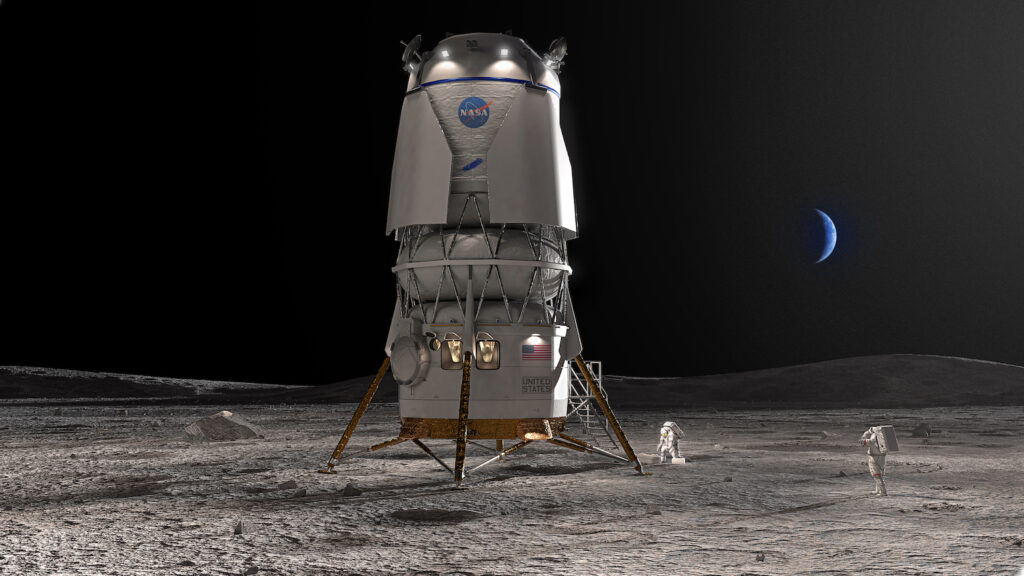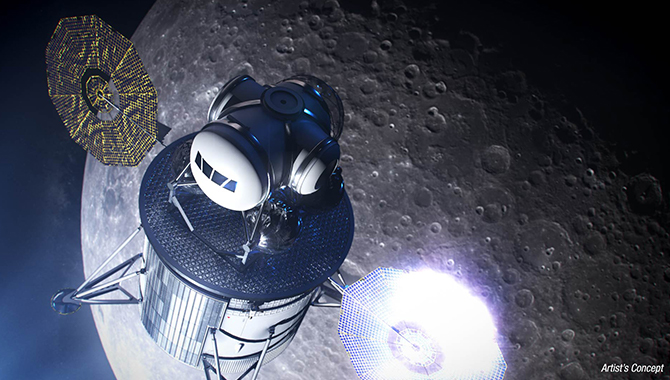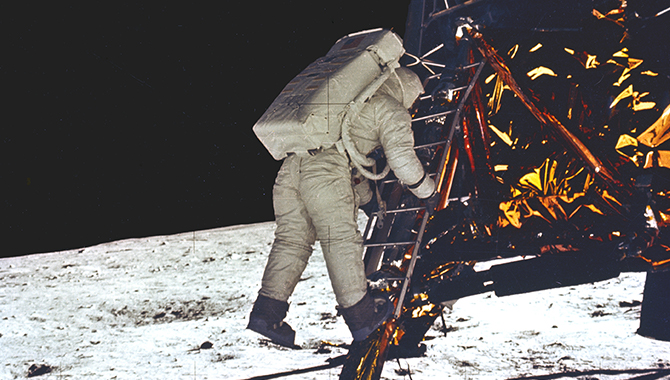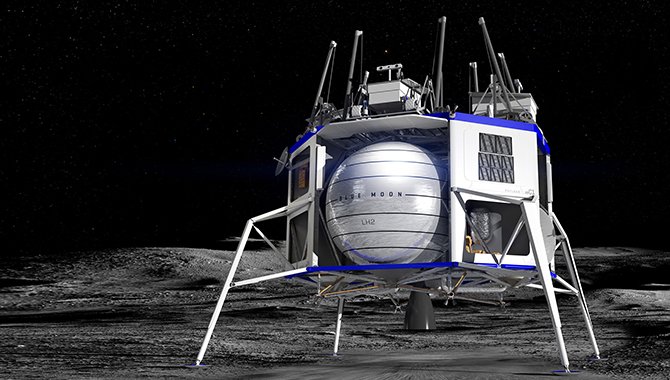
NASA Administrator Bill Nelson gives remarks during the announcement of the company selected to develop a sustainable human landing system for the Artemis V Moon mission, Friday, May 19, 2023 at the Mary W. Jackson NASA Headquarters building in Washington.
Photo Credit: NASA/Aubrey Gemignani
New craft will be designed for extended stays on lunar surface.
After Neil Armstrong and Edwin “Buzz” Aldrin became the first humans to walk on the Moon, they became the first humans to sleep there. The Lunar Module (LM) was small and purpose-built—the first spacecraft designed to carry humans exclusively in space. Weight was at such a premium that the LM’s utilitarian interior didn’t include seats.
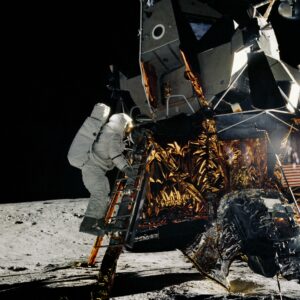
Alan L. Bean, lunar module pilot for Apollo 12, is about to step off the ladder of the Lunar Module (LM) to join Charles Conrad Jr., mission commander, on the lunar surface. The Apollo astronauts faced challenges living and sleeping in the small crew quarters of the LM.
Photo Credit: NASA
Aldrin curled up on the small floor of the LM to sleep. Armstrong awkwardly wedged himself into a higher position, supported by the ascent engine cover, his legs held by a sling he had fashioned. On the perfectly still lunar surface, with an otherworldly combination of bright sunlight and a pitch-black sky, the astronauts found it difficult to sleep, bathed in the glow of illuminated switches. Later Apollo missions would include hammocks, which were hung at an angle.
The Apollo astronauts who landed on the Moon later had mixed experiences. Alan Shepard found it nearly impossible to sleep. John Young “slept like a brick.” Eugene Cernan thought the complete stillness of the lunar surface was eerie as he tried to sleep. Harrison Schmitt found the weaker gravity refreshing.
When Artemis astronauts land on the Moon later this decade, they will arrive in a new generation of lunar landers, dramatically bigger and more capable than the Apollo era landers. NASA is developing these new Human Landing Systems with partners in the private sector. SpaceX is developing landers for Artemis III and Artemis IV. Recently, NASA announced a $3.4 billion firm-fixed price contract with Blue Origin of Kent, Washington, to design, develop, test, and verify the human landing system for Artemis V, currently scheduled for 2029. Blue Origin plans to contribute additional funds, “well north of $3.4 billion,” according to John Couluris, Blue Origin vice president for lunar transportation.
Blue Origin’s Blue Moon lander will stand about 52 feet tall—30 feet higher than the Apollo LM. It will fit within the faring of Blue Origin’s New Glenn heavy lift rocket, which has a diameter of 23 feet. Topped by high-gain antennas for communications with Earth and relay services, the lander features large tanks for liquid hydrogen and liquid oxygen, thermal radiators, and a solar array.
Below that is a large crew module with large windows. This module can support as many as four crew members for as long as 30 days on the lunar surface. The lander is equipped with an airlock that provides easy access to the surface and an adapter for docking with NASA’s Gateway, a habitat, refueling and research center for astronauts exploring the Moon that NASA intends to place in permanent orbit at the Moon.
The Blue Origin Blue Moon lunar lander is capable of landing anywhere on the surface of the Moon, day or night, according to Couluris. “This vehicle also can be configured for a cargo landing mission able to carry up to 20 metric tons in a roundtrip, reusable configuration, or 30 metric tons to surface to form the foundation of habitats and other permanent infrastructure.”
Unlike the Apollo LM, which arrived at the Moon secured within an adapter on the third stage of the same Saturn V rocket that launched the Command Module, these new Human Landing Systems will launch separately aboard commercial rockets. Each is reusable, with plans for refueling in space.
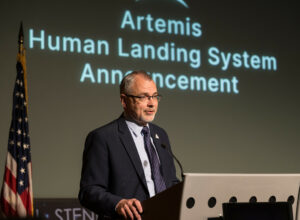
Jim Free gives remarks during an event announcing Blue Origin as the company selected to develop a sustainable human landing system for the Artemis V Moon mission.
Credit: NASA/Aubrey Gemignani
“…Artemis V, which we’re talking about the lander for today, [is] where we’ll really get to that yearly cadence of missions, that’s our goal is to be at that yearly cadence with Artemis V,” said Jim Free, Associate Administrator, Exploration Systems Development Mission Directorate, speaking at a NASA press conference announcing the Blue Origin award.
“We’ll have the crew transfer from Orion to Gateway and then into the Blue Origin lander and go down to the surface. This lander, much like the SpaceX second lander, will have those Sustainable Lander requirements to allow our crews eventually to stay up to 30 days as we build up the infrastructure, which is all based on our Moon to Mars objectives, long-term. Our objectives we’re trying to prove out at the Moon to go onto Mars, and around which we built our recently released architecture.”
Multiple landers with distinct approaches to how they meet NASA’s needs, provides the agency with robust options as NASA moves to establish a regular cadence of Moon landings to carry out science and technology development on the lunar surface in preparation for a human mission to Mars.
“I’ve said it before, we want more competition. We want two landers and that’s better and it means that you have reliability, you have backups. It benefits NASA, it benefits the American people. These are public-private partnerships. It’s the new way that we go to the Moon. It helps NASA share the risk, the technical risk, and the financial risk, the cost, to enable, at the end of the day, mission success,” said NASA Administrator Bill Nelson, speaking at the same press conference.
Blue Origin is working with a team that includes partners Lockheed Martin, Draper, Boeing, Astrobotic Technology and Honeybee Robotics. Blue Origin plans to mature several key technologies by funding a series of pathfinder missions to land on the Moon, demonstrating critical components, subsystem designs, and system behaviors. This is in advance of a required uncrewed test flight of the lander before Artemis V.
“…We will be landing an exact copy of that lander. So, we’ll be testing out full lander systems and the full architecture prior to any astronauts entering the vehicle, and that will be roughly one year prior,” Couluris said.






